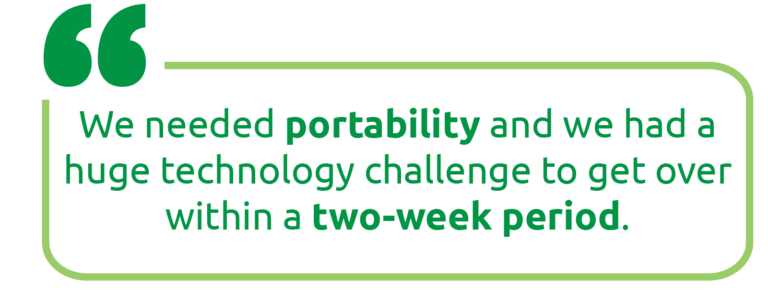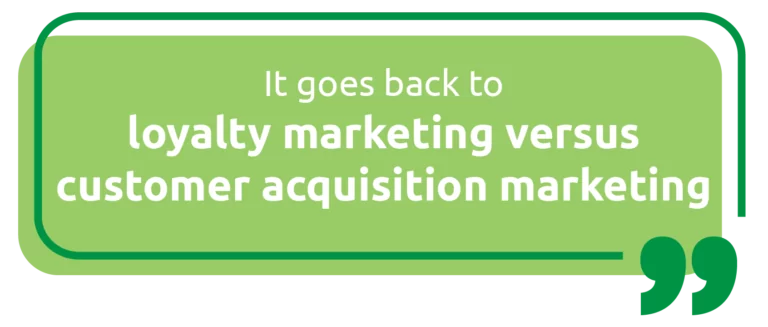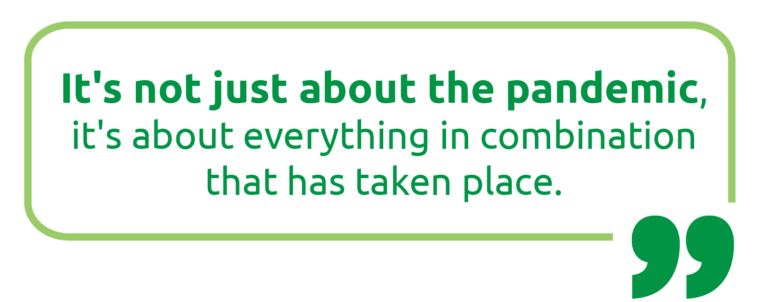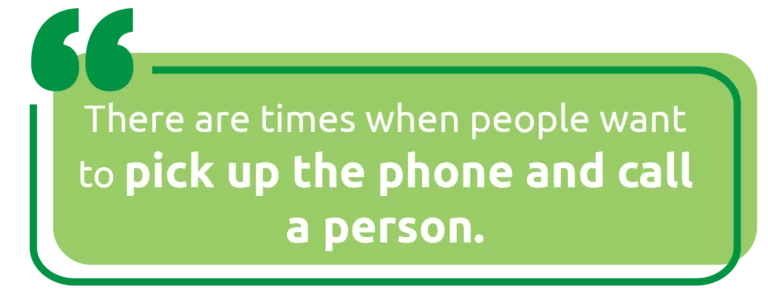Insights
In this first interview article series, Br8kthru sat down with Kristi Gloppen, Vice President of Marketing and eCommerce at Waytek, Inc. Kristi is responsible for everything in the traditional Marketing Communications realm, as well as product and category management, eCommerce revenue and the marketing tech stack.

Our discussion centered around navigating business changes the pandemic brought on and how Waytek shifted its marketing priorities to facilitate stronger connections with customers. Waytek is a mid-size distributor of electrical automotive/vehicle components and wire.
We kicked off our discussion at 4 p.m. on a Monday when Kristi dialed in from Waytek’s headquarters in Chanhassen, MN.
Waytek, Like Many Businesses, Was in a Comfortable Position at the Beginning of 2020
Michelle: When the skies were blue and before the pandemic hit, you were celebrating the 50th anniversary. What was the scene like pre-pandemic for Waytek?
Kristi: Waytek was growing faster than the market. I don’t know if you can feel 100% comfortable, but we felt pretty comfortable where we were. We had a strong labor force, and felt good from an inventory standpoint. We felt all of the different pieces of business were working together.
Michelle: Were there any main marketing initiatives that you were setting the stage for in 2020?
Kristi: Yes, so pre-pandemic we were focused on a couple things. First was new customer acquisition. We knew there was a lot out there that we could bring in. Second we were also focused on nurturing our smaller accounts up to a place where they were focus accounts.
Businesses Experienced Many Challenges Related to the Pandemic, Specifically Requiring an Influx of Technology Purchases to Support Remote Workforces
Michelle: So you had a good employee force, good inventory, and a few initiatives that you could be strategic about and not necessarily reactive about. And then enter March 2020. What were some of the initial effects of pretty much all businesses shutting down?
Kristi: So first off, internally Waytek did not have any processes or technology for people to work from home. So when you think of our customer service teams, who are on the phone all day long, most of them still worked on desktops. We needed portability and we had a huge technology challenge to get over within a two-week period.

We also had the challenge of getting equipment because at the same time we were doing it, all the schools were trying to get laptops. It was really hard to get laptops, and it was a big technology hurdle to get over. So that was the first piece.
While we did that, the main focus was on keeping everybody safe. So the bottom line is our warehouse team is not a team that can work remotely. So there was a lot of time and focus on what we were going to do to keep this team safe and still keep operations running.
We, like most people, started to see the decline in business as people shut down. But we really started to see business pick back up in August and September of 2020. So the downturn did not last long for us.
Changes in Consumer Revenue Influenced the Priorities for Marketing Teams. For Waytek, This Put a Spotlight on Digital Modernization and Brand Definition
Michelle: OK and if we were to fast forward, what has been the main focus over the last two years? Looking back as a whole, how had your efforts shifted?
Kristi: We’ve had a huge initiative that we are driving and getting up to speed, which is going through a digital modernization project to completely replace our existing e-commerce platform and our CMS platform and potentially introduce a PIM platform. So that was just kicking off and in the works when the heat was turned up even higher.
Just like our office employees needing to work from home, our customers also moved to working from home. If you think about our customer base being over 50% procurement folks working from home, they started to rely on our website more than they ever had relied on it in the past. Because of that, it really turned up the fire to ‘We’ve got to get this going now.’
So that’s a huge undertaking. The other big undertaking was answering, do we really understand our customers and understand our market? And do we really know what’s important to them? Not only to customers, but what’s important to prospects? Why aren’t people doing business with Waytek?
So we underwent a project to go through a brand framework and brand definition, including differentiators. We did a lot of surveying of our customers and our prospects to understand, are they looking for the same thing? And the response was no, they’re not.
Our existing customers who have been with us for a long time are looking for some of the relationship, emotional type of traits I would say, like having the convenience of talking to a friendly person.
For prospects, it’s very much a function of what they’re looking for. They’re looking for stock, price, and quality. They’re not coming from the standpoint of needing to have a contact person who is friendly. That’s not what they care about mainly.
So as we dug into it a little further we found that obviously our customers go through a lifecycle and an evolution. And what might have brought them in isn’t what keeps them in.
It goes back to loyalty marketing versus customer acquisition marketing—and it really started to paint a clear picture for us that the two are very different types of approaches that we need to take. That’s not going to change.

Michelle: Oh I love that. So of pre-pandemic you were focused more on new customers and moving them up to focus accounts, but because of the pandemic and everything halting, you were more introspective to learn more about your customer base and what they really needed from Waytek.
Kristi: Exactly. So while we’re not quite there yet, we will be launching a brand refresh and a new messaging platform over the next couple months.
The Pandemic Required Many Marketing Teams to Hustle and Tackle New Challenges
Michelle: Do you think any of that would’ve come to life as fast as it did had we not gone through the pandemic?
Kristi: I think it might have happened a little bit faster, yeah. Like I said, our downturn wasn’t long. So growth turned around still in 2020 in Q4. So we’ve been hiring to help fill some of those gaps, but there’s definitely more than enough work to go around, which has slowed down some of those key projects.
Some Challenges Became Worse as Demand for Products Shot Up—Especially With the Supply Chain
Michelle: Shifting the conversation a bit, I know that one of the key drivers for Waytek is the product supply, and that the economy has been all sorts of crazy with different supply chain issues. Can you give a concrete example of a product that’s been backed up and how that’s affected Waytek?
Kristi: There’s a lot of different products backed up; for example relays are always challenging. Most relays are produced in China, and everything there was hit with a double whammy. First it was their workers and COVID, and then there were shipping delays and not being able to get shipping containers out. Then you’ve got all the ports backed up. So it really is multiple things. If we look at relays, which used to run 12 to 14 weeks lead time, many are out at a year lead time right now. So at that point, for people looking for relays, stock is everything, because they need to keep their line up. Whoever’s got inventory is going to get the business.
Other Challenges Layered Onto the Pandemic, Such as the Deep Freeze in Texas That Affected One of the Largest Plastic Suppliers
Kristi: So that’s our current challenge, but that’s just one example. One of the issues people were talking about was the deep freeze in Texas with the plastics which caused significant supply chain issues as well. All the plastic that froze was stored outside. So when it froze, the composition of it deteriorated, so it was no longer at spec for some of these parts.
A part might not be fully made of that plastic, but in some cases it might just be the button of a switch. So it’s one little teeny piece of the overall product. But if you can’t get the button, you can’t finish your part and you can’t ship, which leads to us not getting inventory. So there are a lot of things that happened in combination. It’s not just about the pandemic, it’s about everything in combination that has taken place. The labor shortage is at the root of a lot of it as well.

If you look at a distributor, we sit in the middle. We buy from the manufacturers and we sell the manufactured parts to our customers. A lot of customers used to bypass us. They just bought directly from the manufacturer because they bought such huge quantities.
But now they can’t get what they need anymore because there’s nothing left to ship from the manufacturer. That’s why we have these direct customers coming to buy our inventory, which you would think—wow, great problem to have.
Through the Ups and Downs, Waytek Remained Focused on Doing What’s Best for Their Customers to Build Long-Term Relationships of Trust
Kristi: However, let’s say Company A came in and said, you have 100,000 of these, I want all 100,000. Then we would have no availability for our existing loyal customers. So we’ve had to look into ways we could make sure we’re taking care of existing customers while still servicing new customers. That’s a technology challenge—how do we re-code our technology to only show 50% of this product’s stock on our website. There’s been a lot of technology changes to make as well.
Michelle: I can only assume that these are ongoing/future state, like with your overhaul of your technology system, you’re incorporating these as requirements going forward.
Kristi: Right. Our industry always ebbs and flows, like most industries. This is going to be a longer challenge from inventory standpoint, since some parts are still out at one-year lead times. However, a year and a half from now, I’m going to say plus or minus six months, eventually there will be an inventory glut because people are out buying as much as they can get because they don’t want to go line down. So when it becomes easy to get parts, they’re already going to have their inventory, so they won’t need to buy for a while.
So it’s also, what are you planning from a marketing standpoint to help mitigate that? Are you bringing in enough new customers to mitigate the whiplash once there’s enough inventory available? Have you made them loyal customers so they’re not going to go back to the old person they were buying from?
Mitigating Whiplash and Being More Efficient With Communications Are Two Musts for Waytek
Michelle: Yeah, absolutely. So let’s talk about the immediate strategy for communicating some of these delays with customers, and then more of how that’s evolved over time as you’re looking at these diverse audiences and what they need from a short-term and long-term standpoint. When this first hit and you were having delay issues and you knew that you needed to communicate that with customers, has the way that you communicated initially changed over the last year to how you’re doing it now?
Kristi: Yes because there are more challenges. In some cases we’ve had to take an approach of emailing. It might look personalized to the person from their salesperson, but marketing is emailing it on behalf of the salesperson, because there’s not enough time in a day for that person to help service everybody that can’t find parts and to call 200 customers, and tell them hey, if you need this part, you better get it now.
Like Many Businesses, Doubling Down on Customer Service Became a Must for Waytek
Kristi: That’s how a big chunk of customers were trying to order. More have gone to the web. However, customer service is busier than they’ve ever been because now all the phone calls are not about placing orders, they’re all about, hey I placed this order, how soon can I get it? Or when do you think you’re going to get your inventory in? And is there any way that you can change my shipping to overnight? Or is there any way you can guarantee that it gets out today because I’m going to go line down.
So they’re fielding all of those types of conversations. They’re completely overloaded as well, even though more of the new customers have shifted to the web. So when you talk about communicating, there’s just some things that you can’t communicate electronically. There are times when people want to pick up the phone and call a person.

They want to know what’s going on. That’s where I think B2B and B2C differ a little bit because if I order something from Amazon and it doesn’t come in, I’m just going to keep tracking it. I’m not going to pick up the phone and call somebody at Amazon to see where my order is. B2C is starting to shift away from that. But in B2B, it’s very much still a challenge. You have to have people and the staff to support that.
Fast Shifts in Priorities During the Pandemic Unearthed Strategies That Companies Will Continue to Embrace Going Forward, Such as Emailing on Behalf of Salespeople and Investing More in PPC
Michelle: Wow, OK. This has been such a can of worms that is much more complex than I thought Waytek was going through. So wrapping our conversation here, can you talk a little bit about some of the strategies that you’ve uncovered over the last year and a half or two years that you definitely will continue embracing going forward?
Kristi: We will still continue embracing sending out marketing emails on behalf of salespeople just because it is more scalable. Also we’re focused on what has become most important for new customers, finding parts. It’s been all about paid search, SEO and vertical search engines, where vertical search engines had been a very small piece of our sales number coming into the pandemic.
Vertical search engine revenue has gone up significantly from where it had been before. So that’s huge growth and something that we will have to keep doing into next year.
Michelle: Yeah, I love it, and it’s probably exactly where you all need to be. All right, my favorite question: hindsight is 20/20. If you could leave your past self with one piece of wisdom, what would you tell yourself about the company or marketing challenges to come?
Kristi: Hmmm, hire more staff faster because sometimes things get caught in red tape—and what people forget is the day you hire someone, they’re a new employee and they’re not 100% productive. They need to be onboarded, then get up to speed, and in most cases that’s a six month process. So hire more people faster is one. The second one is put as much money into paid search as you can because that’s where people are going to go when they can’t find what they need. They’re all going to go to search and start there. It’s different when they can find things. They just go to distributor sites to see who has the best cost.
And then the last piece, I would say, because this has been a huge problem for us, is pay attention to your data, make sure that you have clean data so that you can segment and target the way that you need to when things like this happen because you don’t have time to do the manual processes that you have been doing for so long. Everything needs to be automated as much as possible because you don’t have time. And when your data is dirty, you don’t have a choice except for just doing some things manually. So that would be my third thing, pay attention to your data and make sure that the integrity of your data is solid.
Michelle: Salient advice in everything that’s going on right now. I think a lot of companies can relate to those three points.
Keep an eye on our Insights article for the next Straight Talk interview. Sign up for Br8kthru’s emails to get articles like these delivered to your inbox.